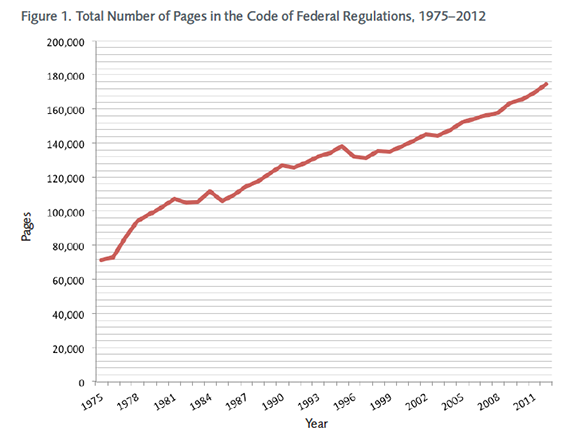- | Regulation Regulation
- | Federal Testimonies Federal Testimonies
- |
The Searching for and Cutting Regulations That Are Unnecessarily Burdensome Act of 2014
Testimony Before the House Committee on the Judiciary, Subcommittee on Regulatory Reform, Commercial, and Antitrust Law
In examining the reforms under consideration, first, I will discuss why regulatory accumulation is a public policy problem: regulatory accumulation creates substantial drag on economic growth by impeding innovation and entrepreneurship.
Chairman Bachus, Ranking Member Johnson, and members of the committee: thank you for inviting me to testify today. As an economist and senior research fellow at the Mercatus Center at George Mason University, my primary research focuses on regulatory accumulation and the regulatory process, so it is my pleasure to testify on today’s topic.
The accumulated stock of regulations contains a multitude of unnecessary burdens. As the title of the legislation that is the subject of this hearing implies, the current regulatory system makes it difficult to identify and eliminate such unnecessary burdens.
In examining the reforms under consideration, first, I will discuss why regulatory accumulation is a public policy problem: regulatory accumulation creates substantial drag on economic growth by impeding innovation and entrepreneurship.
Second, I will discuss the search for obsolete, unnecessary, duplicative, or otherwise nonfunctional regulations, covering both why similar searches in the past have failed and what could be done differently to increase the odds of success. In my estimation, an independent group or commission is necessary to successfully identify unnecessary regulatory burdens.
Third, I will address the difficulties of eliminating unnecessary regulatory burdens, once identified. Here I point to the wisdom of the crafters of the BRAC process.
Finally, I will cover specific recommendations for effectively reducing the problem of regulatory accumulation and compare the SCRUB Act to these recommendations.
Regulatory accumulation may be a term that few people understand, although its consequences can be substantial. It is worthwhile to define what I mean by the terms “regulation” and “regulatory accumulation.” As I have written in previous congressional testimony, regulations restrict choices by design.1 In its most basic definition, a regulation is a law that “seeks to change behavior in order to produce desired outcomes,” and it does this by requiring or forbidding certain actions.2 Federal regulations, published in the Code of Federal Regulations, can place restrictions on the choices of individuals, large manufacturers, high-tech startups, small businesses, state and local governments, and even the federal government itself.
 Measuring Regulatory Accumulation
Measuring Regulatory Accumulation
Federal regulation in the United States has consistently grown for decades. One way to measure the growth of federal regulation is to count the number of pages published each year in the Code of Federal Regulations. The Code of Federal Regulations is published annually and contains the legal text of all federal regulations in effect each year. That means one can simply look at the number of pages published in the Code of Federal Regulations in a given year to get a rough approximation of the extent and complexity of all federal regulations in effect in that year. Figure 1 shows the number of pages published in the Code of Federal Regulations each year from 1975 to 2012.
As figure 1 shows, the number of pages published in the Code of Federal Regulations has grown over the tenures of all recent presidents. In 1975, there were 71,224 pages of regulation. In 2012, 174,545 pages of regulation were published.3
 Of course, not all pages are the same. Another way to assess the extent and complexity of federal regulation is to look at the actual number of restrictions—words that create binding, legal obligations either to do something or not to do something, such as “shall,” “must,” and “may not.” This permits a more narrow focus on the components of regulatory text that are truly restrictive, as opposed to, for example, text that merely provides information or opinion. In a project called RegData, made publicly available on the website of the Mercatus Center at George Mason University, economics professor Omar Al-Ubaydli and I have done exactly that.4 Figure 2 shows the total number of regulatory restrictions published in regulatory text in the Code of Federal Regulations from 1997 to 2010.
Of course, not all pages are the same. Another way to assess the extent and complexity of federal regulation is to look at the actual number of restrictions—words that create binding, legal obligations either to do something or not to do something, such as “shall,” “must,” and “may not.” This permits a more narrow focus on the components of regulatory text that are truly restrictive, as opposed to, for example, text that merely provides information or opinion. In a project called RegData, made publicly available on the website of the Mercatus Center at George Mason University, economics professor Omar Al-Ubaydli and I have done exactly that.4 Figure 2 shows the total number of regulatory restrictions published in regulatory text in the Code of Federal Regulations from 1997 to 2010.
Figure 2 corroborates the impression given by figure 1: regulation has been consistently growing. Moreover, these measures of regulation allow economists to study the consequences of the accumulation of regulation.

